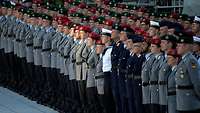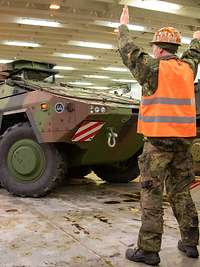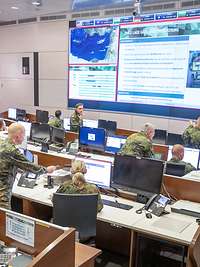
The organisation of the Bundeswehr
The Bundeswehr consists of the Armed Forces and the major civilian organisational elements.



The Bundeswehr consists of the Armed Forces and the major civilian organisational elements.
Within the organisational structure of the Bundeswehr, the Armed Forces form the military core. They include the Army, Navy, Air Force, and Cyber and Information Domain Service as well as the Bundeswehr Joint Support Command, which provides military capabilities that all Services require, such as logistics or medical services.
Besides these major military organisational elements, there is the civilian Federal Defence Administration. It is divided into three major organisational elements: Personnel, Equipment and Infrastructure. The Military Chaplain Service and the Military Legal System have the status of independent major civilian organisational elements. Moreover, there are a number of civilian and military agencies directly subordinate to the Federal Ministry of Defence: the Bundeswehr Joint Force Command, the Bundeswehr Command and Staff College, the Leadership Development and Civic Education Centre, and the Federal Office of Military Counterintelligence.
The organisation of the Bundeswehr is clearly geared to the requirements of national and collective defence.
The Bundeswehr adheres to the general principle of a separation between the Armed Forces and the civilian Federal Defence Administration. In accordance with Article 87b of the Basic Law for the Federal Republic of Germany, it is imperative that personnel and armaments management be in the hands of a civilian structure. However, this does not mean that there are no military personnel working in the Federal Defence Administration and no civilian personnel in the Armed Forces. In fact, both cases exist, depending on the specific post concerned.
The German constitution does not contain any other provisions regarding the structure of the Bundeswehr. “The Federation shall establish Armed Forces for purposes of defence. Their numerical strength and general organisational structure must be shown in the budget”, Article 87a of the German Basic Law states. Thus, apart from the mission of national defence, it is financial resources that determine the structure of the Bundeswehr. Any decisions concerning changes to this structure fall within the responsibility of the Executive Group of the Federal Ministry of Defence.
The four Services of the Bundeswehr are the Army, Air Force, Navy, and Cyber and Information Domain Service. As a general rule, each Service fights in its own operational domain: The Army fights on land, the Navy at sea, the Air Force in the air and in space, and the Cyber and Information Domain Service in the cyber and information space. However, there are a couple of exceptions to this rule. Army and Naval Aviation forces, for example, operate in the air domain. Similarly, the Air Force force protection forces and the Sea Battalion’s naval infantry forces fight on land. Finally, digitalisation causes Cyber and Information Domain Service personnel to be active in all domains.
The Services are structured in a way that allows them to take on general military responsibility for their respective operational domains, that is, for the land, air, maritime, and cyber and information domain. In this context, the following applies: “The ability to fight and to provide combat support are still the main features of, and benchmarks for, the successful employment of the Bundeswehr.” This is why, according to the Defence Policy Guidelines quoted here, national and collective defence as well as successful deterrence have top priority. At the same time, conflicts are not confined to isolated areas. Therefore, all elements of the Bundeswehr must be structured in a way that enables them to achieve military effects in a cross-domain approach as well.
In addition to the four Services, there is the Bundeswehr Joint Support Command. This Command provides key capabilities that all Services require for mission accomplishment. Most importantly, it provides scarce resources in a flexible manner.

Effective support forces are crucial to ensuring the warfighting capability and sustainability of armed forces. But why is this the case?
Headed by the Bundeswehr Joint Support Command Headquarters, the Bundeswehr Joint Support Command pools capabilities – such as medical care, logistics, CBRNchemical, biological, radiological, nuclear defence, military policing and civil-military cooperation (CIMICCivil Military Co-Operation) – as well as central military agencies, such as the Bundeswehr Office for Defence Planning. In this way, it increases the sustainability of the combat troops in all operational domains. Furthermore, the Bundeswehr Joint Support Command operates the Bundeswehr’s training areas.
Across all operational domains, the Bundeswehr Joint Force Command exercises command and control over Bundeswehr operations in Germany and abroad. It is the central point of contact – both for Germany’s Allies and other multinational partners and for stakeholders within Germany – when it comes to the employment of the Armed Forces. The Command not only exercises command and control over operations but also plans them. Moreover, it is in charge of the Bundeswehr’s regional territorial commands.

In future, the Bundeswehr will plan and conduct its operations at home and abroad from a single command in Berlin and Schwielowsee.
In addition to the Armed Forces, the Bundeswehr also has civilian organisational elements. These include the Federal Defence Administration as well as the Military Legal System and the Military Chaplain Service. The Federal Defence Administration is subdivided into the three major organisational elements of “Personnel”, “Equipment, Information Technology and In-Service Support” and “Infrastructure, Environmental Protection and Services”.
The organisation of the Bundeswehr includes a number of agencies that report directly to the Federal Ministry of Defence. These are the Bundeswehr Joint Force Command, the Bundeswehr Command and Staff College, the Leadership Development and Civic Education Centre, and the Federal Office of Military Counterintelligence.
The structure of the Bundeswehr was last adjusted in 2024 and 2025. Since then, it has been clearly geared to the requirements of national and collective defence and of the new era. The recent restructuring of the Bundeswehr was done with the goal of warfighting capability in mind. More precisely, the aim was to speed up decision-making and coordination processes, reduce the number of interfaces, and strengthen the lower tactical levels.